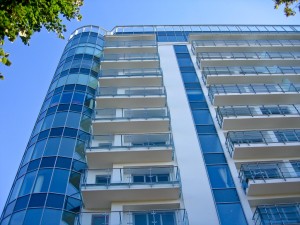Sustainable Living & Sustainable Lifestyle
3 Green Buildings with Health and Environmental Benefits
The American Institute of Architects recently recognized several green buildings as models of environmental sustainability. All of the structures were built to be as eco-friendly as possible; for example, they tap into renewable energy sources and include native vegetation on site. In addition, many of the buildings provide health benefits as well, encouraging occupants to use public transit networks and maintaining a commitment to air quality. The following three buildings on the American Institute of Architects (AIA) list stood out for their particularly impressive features.
 Merritt Senior Apartments are located in Oakland, California, and provide the perfect place for seniors to call home. Built close to a public transit station, the homes allow residents easy access to a number of transportation options. The building also caters to its low-income residents; energy use is kept at a minimum, the result of a rooftop solar water heater and the strategic placement of fans throughout the building. In addition to these practical features, designers also considered the residents’ social and emotional needs when constructing the property. For example, native vegetation was used to attract birds in the area, making the grounds the perfect place for seniors to immerse themselves in the sights and sounds of nature.
Merritt Senior Apartments are located in Oakland, California, and provide the perfect place for seniors to call home. Built close to a public transit station, the homes allow residents easy access to a number of transportation options. The building also caters to its low-income residents; energy use is kept at a minimum, the result of a rooftop solar water heater and the strategic placement of fans throughout the building. In addition to these practical features, designers also considered the residents’ social and emotional needs when constructing the property. For example, native vegetation was used to attract birds in the area, making the grounds the perfect place for seniors to immerse themselves in the sights and sounds of nature.
Milwaukee’s Clock Shadow Building was constructed with salvaged materials and designed to minimize energy use. Because the area is susceptible to extreme temperature fluctuations, a ground-source water heat pump was installed to support the use of thermal heating and cooling systems. Whenever possible, though, occupants of the building simply rely on a number of south-facing windows to both draw in heat and let in cool air, depending on the season. Housed within the building are several non-profit groups that provide health services to area residents. For example, one clinic works with the uninsured to provide quality care at no cost.
Situated in Venice, California, the Yin Yang House was originally a 1200-square foot residence that was built in the 1960s. Part of the original structure was retained, but designers also made a number of improvements, cutting back on pollution and making air quality a priority. For example, the cabinetry is formaldehyde-free and the fluorescent lighting has very little mercury in it. All of the electricity for the home is generated on-site, and the property even includes a storm water retention system.
The push to “go green” is being embraced by private citizens and institutions across the country. It is not unusual, for example, to see someone biking to work in a large city or to find pest control in Connecticut that specializes in integrated pest management techniques. Green construction is quickly catching on as well, and the three properties mentioned above are certainly shining examples of what can be accomplished with a little ingenuity.